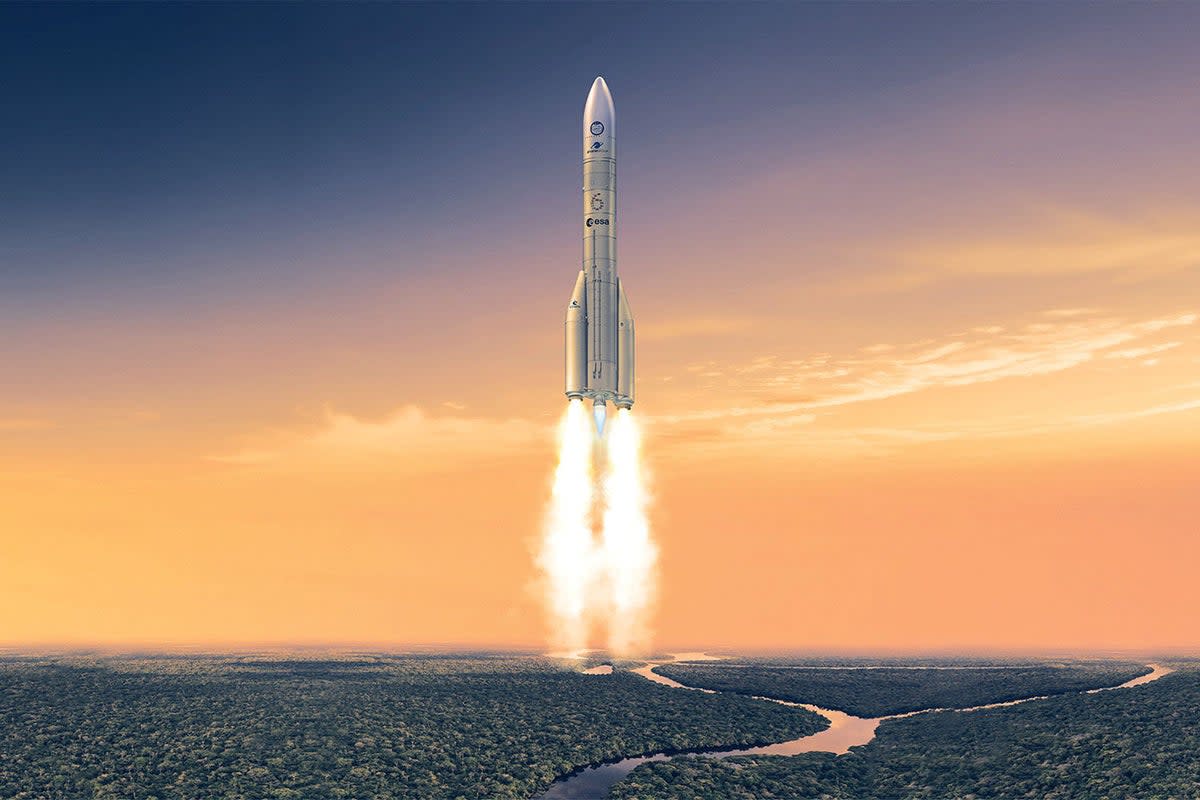What is Ariane 6? How to watch the first flight of Europe's new rocket

Ariane 6 is a spacecraft made in co-operation with the European Space Agency. And it’s late.
After years of development, it was originally intended to fly in 2020. It was delayed until 2021, then late 2023. We are finally approaching the launch, almost a decade after the Ariane 6 project began.
Ariane 6 will take a handful of small payloads into orbit for its first flight, including some German satellites and Nasa’s CubeSat Radio Interferometry Experiment (Curie), designed to measure radio waves emanating from the sun and elsewhere.
Here’s what you need to know about the key European competitor to SpaceX.
When and where will Ariane 6 launch?
Ariane 6 is scheduled to launch between 7pm and 11pm UK time on Tuesday, July 9.
Its launch site is in French Guiana. There’s a European spaceport just outside the town of Kourou, called the Guiana Space Centre.
How to watch the Ariane 6 launch
The European Space Agency (ESA) will hold a live stream of the launch on its ESA Web TV One channel. It’s due to begin an hour before launch, from some point around 6pm.
Its YouTube channel will also broadcast a live stream, which begins at 6.30pm.
What is Ariane 6?
The Ariane 6 is an ESA spacecraft, the European equivalent of SpaceX’s Falcon 9 rocket.
It has been developed since the end of 2014, but its initial launch plans have been delayed for four years.
Part of Ariane 6’s aim is to keep Europe somewhat competitive in this particular satellite-launching space race or to “maintain Europe’s leadership in the fast-changing commercial launch service market,” to use the ESA’s words.
Since the beginning of the Ariane 6 project, its predecessor Ariane 5 has had 40 launches, compared with the 200-plus of rival SpaceX.
How big is Ariane 6?
Ariane 6 is 63 metres tall and will weigh around 900 tonnes when fully loaded. That’s the weight of more than 750 Vauxhall Corsas.
It features a main-stage rocket and two or four boosters, depending on the configuration. These take the payload, which is stored towards the nose of the Ariane 6, into space. The first flight of the Ariane 6 will be a two-booster variant.
The upper part has a rocket engine. This one can fire multiple times, to allow Ariane 6 to deposit payloads at different orbits. A final burn is also used to push this upper stage out of orbit, to avoid becoming space junk.
ArianeGroup, a venture of Airbus and Safran, made Ariane 6 for the ESA.
How much did Ariane 6 cost?
Ariane 6 is estimated to have cost around £3.4 billion to develop.
According to La Tribune, ArianeGroup asked for an additional £177 million a year to run the project, over the £118m it already receives, in late 2023. This amounts to almost £300m a year.
The actual cost of the rocket hardware has not been announced. It is estimated to be around £60m for the dual-booster variety and about £100m for the four-booster Ariane 6 design.
Is Ariane 6 reusable?
Unlike Falcon 9, Ariane 6 is not a reusable design. A fresh rocket is required for each launch.
The ESA has said it does not need a reusable design because few launches are required.
“When we’ll launch frequently, in the future, we’ll need reusability for economic reasons,” the ESA’s director of space transportation, Toni Tolker-Nielsen, told SpaceNews.
Ariane 5 vs Ariane 6
The craft’s predecessor, the Ariane 5, had its first flight in 1996. However, there were five generations of the Ariane 5 rocket over the years, and a sixth was planned before being cancelled in favour of the Ariane 6 project.
The original Ariane 6 concept was reportedly to create a relatively simple rocket that could send a satellite into space for the least possible amount of money. However, the final design is closer to a natural evolution of Ariane 5.
Ariane 6’s rockets are “bigger and more powerful than before,” says ArianeGroup. “Ariane 6 will be able to carry more satellites than Ariane 5 — and heavier ones.”
What comes after Ariane 6?
There are already 30 launches booked in for the Ariane 6, for commercial and more scientific purposes. That accounts for missions years away. too. Six are pencilled in for 2025 and another eight for 2026.
Ariane 6 is expected to be the ESA’s rocket workhorse for over a decade (Ariane 5’s iterations were in operation for 27 years), but plans for a successor are already in mind.
A 2020 paper by a Centre National d’Etudes Spatiales (National Centre for Space Studies) engineer introduced the idea of “Ariane Next,” a potentially reusable rocket of the future that could reduce launch costs significantly. The paper suggested this system could be around in the 2030s.
But it also claimed Ariane 6 would launch in 2020. That proposed timing may be optimistic.

 Yahoo News
Yahoo News 
